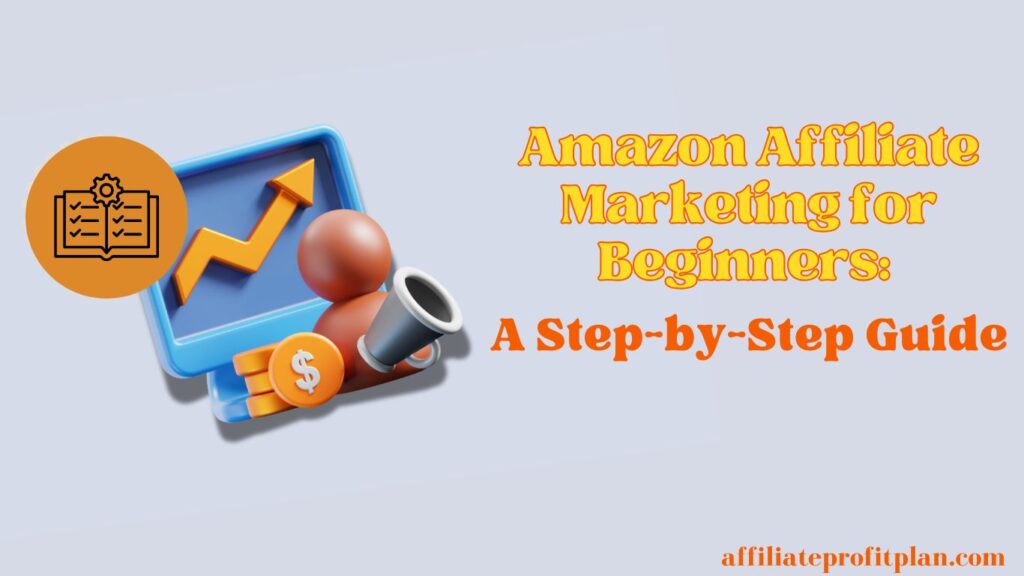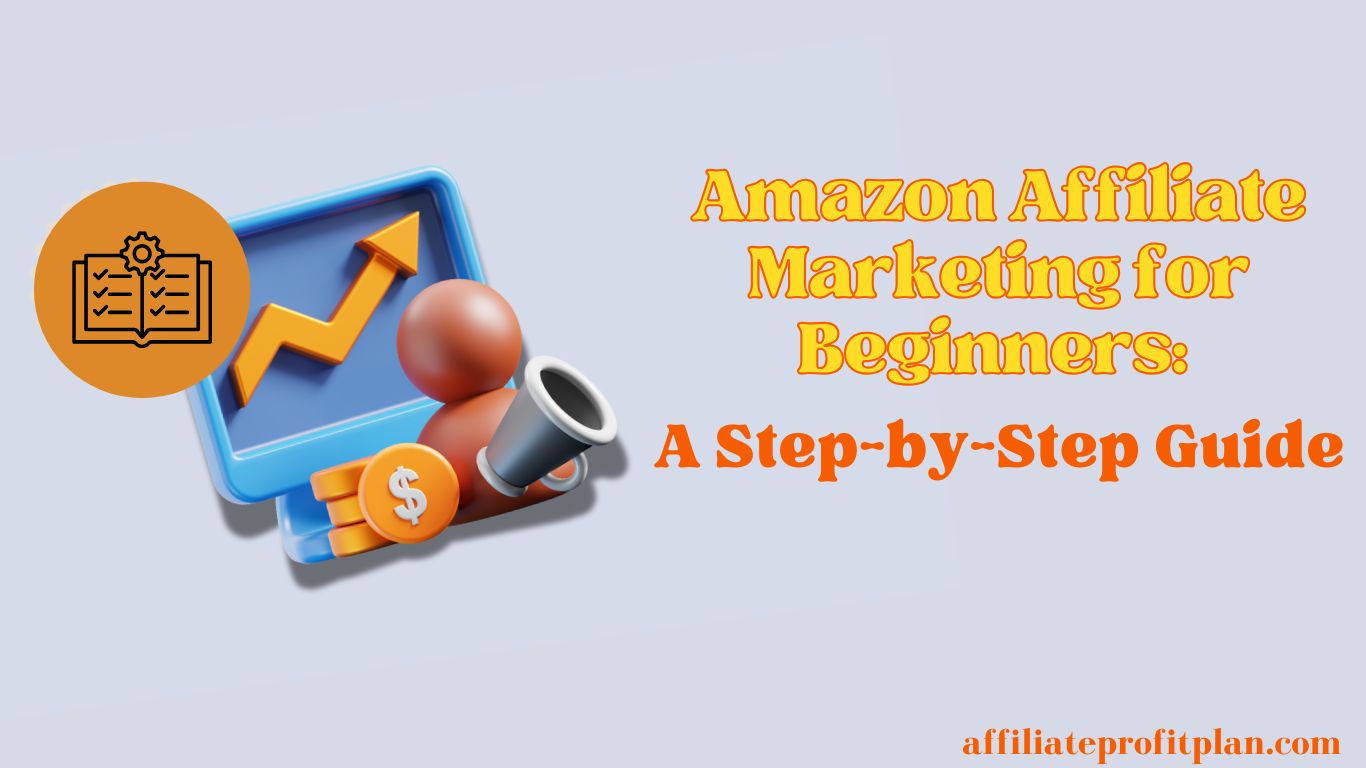Welcome to my article Amazon Affiliate Marketing for Beginners: A Step-by-Step Guide. Ever dreamt of making money while you sleep? No, I’m not talking about some get-rich-quick scheme or a magic formula that’ll make you a millionaire overnight. I’m talking about Amazon Affiliate Marketing—one of the easiest and most beginner-friendly ways to earn passive income online. With over 2.5 billion monthly visitors, Amazon is the go-to marketplace for just about anything, which means there’s always an opportunity to make commissions by recommending products people are already looking for.
So, how does it work? Simple. You sign up for Amazon’s Affiliate Program (Amazon Associates), grab a unique link for any product you want to promote, and when someone makes a purchase through your link, you earn a commission. Sounds easy, right? Well, there’s a little more to it—choosing the right niche, creating content that actually converts, and figuring out how to drive traffic to your links. But don’t worry! In this step-by-step guide, I’ll walk you through everything you need to know, from signing up to Amazon’s affiliate program to turning clicks into commissions. Let’s dive in and get you started on your affiliate marketing journey—because who doesn’t like the idea of making money from the comfort of their couch?
Access My Proven Blueprint for $50-$100 Daily Income – Watch This FREE Video Now >>>

Understanding Amazon Affiliate Marketing
Let’s break it down: Amazon Affiliate Marketing is like getting paid to be a friendly shopping assistant—without ever having to set foot in a store. You recommend products, people buy them, and Amazon rewards you with a commission. No need to stock inventory, deal with customer service, or worry about shipping logistics. Sounds pretty sweet, right?
Now, here’s how it works: When you sign up for Amazon Associates, you get access to special affiliate links. These links track when someone clicks on them and makes a purchase. The best part? You don’t just earn commissions on the specific product you recommended—you earn a commission on anything the person buys within 24 hours. So if they click your link for a $30 yoga mat but end up buying a $1,200 treadmill, guess what? You just got paid for that treadmill too. (Talk about an unexpected workout for your bank account!)
But before you start daydreaming about piles of affiliate cash, there are some things to keep in mind. Amazon’s commission rates vary by product category, ranging from 1% to 10%. That means promoting high-ticket or high-commission items (like luxury beauty products or premium home gadgets) can be more profitable than, say, budget paper towels. Plus, Amazon has strict rules—like no misleading promotions or spamming links—so following their guidelines is key if you want to stay in the game.
In short, Amazon Affiliate Marketing is a low-risk, beginner-friendly way to monetize your content—whether it’s through a blog, YouTube channel, or even social media. Now that you know how it works, let’s move on to the next step: signing up and getting started!
How to Sign Up for the Amazon Associates Program
Alright, now that you know what Amazon Affiliate Marketing is, it’s time to get your hands on those commission-generating links! The good news? Signing up for the Amazon Associates Program is free and takes less than 10 minutes. The bad news? If you try to rush through without setting things up properly, you might end up scratching your head later. But don’t worry—I’ve got you covered with this step-by-step guide.
Step 1: Go to the Amazon Associates Website
Head over to Amazon Associates (affiliate-program dot amazon dot com) or your country-specific version and hit the big “Sign Up” button. If you already have an Amazon account, you can log in with that. If not, you’ll need to create one. Easy peasy.
Step 2: Enter Your Account Information
Amazon will ask for your name, address, and phone number. No, they’re not being nosy—it’s just so they can pay you when those sweet commissions start rolling in. Make sure you enter accurate details because Amazon will eventually need to verify your identity for tax purposes.
Step 3: Add Your Website or Social Media Channels
Amazon wants to know where you’ll be promoting their products. If you have a blog, website, YouTube channel, or even a big social media following, add those links. But here’s the catch: Amazon expects real content—so if you’re just starting out, it’s best to have at least a few posts, videos, or pages live before applying.
Step 4: Set Up Your Profile
Now, Amazon gets a little nosy again (but for good reason). They’ll ask you:
✔️ What your website or content is about
✔️ How you plan to drive traffic (SEO, social media, ads, etc.)
✔️ Which Amazon categories you’re likely to promote
Answer these questions honestly. Amazon uses this info to evaluate your application, and trust me, they can smell a fake application from a mile away.
Step 5: Enter Payment and Tax Information
Unless you’re doing affiliate marketing for the fun of it (which, let’s be honest, you’re not), you’ll want to get paid. Amazon offers two payment options:
💰 Direct Deposit – Fast, easy, and straight to your bank account.
💰 Amazon Gift Card – If you love shopping on Amazon, this might be a fun way to get paid.
You’ll also need to fill out tax information, especially if you’re in the U.S. Amazon will guide you through the process, and it’s pretty straightforward.
Step 6: Get Your Unique Affiliate Links and Start Promoting!
Once Amazon approves your account (which usually happens instantly), you can start generating your own unique affiliate links from the Amazon Associates dashboard. Just search for a product, grab the link, and share it with your audience. Every time someone buys through your link, you earn a commission.
🚨 Pro Tip: Amazon gives you 180 days to make your first sale—if you don’t, your account gets deactivated. So don’t just sign up and forget about it—start promoting those links ASAP!
And that’s it! You’re officially an Amazon Associate. Now, let’s move on to the next big question: how to choose the right products and niche to maximize your earnings.
Choosing the Right Niche and Products to Promote
So, you’ve signed up for Amazon Associates, and now you’re staring at millions of products, wondering, What the heck am I supposed to promote? Should you go for high-ticket electronics? Trendy home gadgets? Or maybe pet accessories for dogs that live a more luxurious life than you?
Access My Proven Blueprint for $50-$100 Daily Income – Watch This FREE Video Now >>>
Here’s the deal—choosing the right niche and products is crucial. Pick something too competitive, and you’ll be buried under thousands of other affiliate sites. Choose something too obscure, and you might hear nothing but crickets. So, let’s break it down and find the sweet spot.
Step 1: Pick a Niche That You (and Others) Actually Care About
A niche is basically the category or industry you’ll focus on. The goal is to find one that’s profitable but not oversaturated. Here’s what to consider:
✔️ Passion & Knowledge – If you love the topic, creating content will be easier (and way less boring). Are you a fitness freak? A tech nerd? A home décor enthusiast? Start there.
✔️ Demand & Market Size – Use Google Trends and Amazon’s Best Sellers page to see if people are actually interested in your niche.
✔️ Competition Level – If every big-name influencer and giant website is already dominating the niche, it’ll be tough to rank in search engines. Look for areas with moderate competition but still enough demand.
🔥 Winning Niche Examples:
- Home Office Essentials (Standing desks, ergonomic chairs)
- Smart Home Devices (Smart lights, security cameras)
- Outdoor & Adventure Gear (Camping, hiking, fishing)
- Pet Accessories (Automatic feeders, GPS trackers)
- Health & Wellness (Massage guns, fitness trackers)
Step 2: Choose Products That Actually Make Money
Not all Amazon products are created equal. Some pay higher commissions than others, and some convert better because people actually want to buy them. Here’s what to look for:
💰 High Commission Categories – Amazon’s affiliate rates range from 1% to 10%, so it’s important to know which categories pay well. For example:
- Luxury Beauty – Up to 10% commission
- Home, Kitchen & Furniture – 8%
- Health & Personal Care – 5%
- Electronics & PCs – 3% (Low, but high-priced items can still be profitable)
- Amazon Devices (Echo, Kindle, Fire TV) – 4%
🎯 Evergreen vs. Trendy Products – Evergreen products (like kitchen tools or fitness equipment) sell year-round, while trendy products (like the latest gaming console) might give you a short-term spike in earnings. A mix of both is ideal.
🔄 Recurring & High-Ticket Products – Subscriptions (like Amazon Prime, Audible, and Kindle Unlimited) offer bounties—one-time commission payments per sign-up. High-ticket items (like treadmills or laptops) pay lower percentages but can still bring in big commissions.
Step 3: Check the Product’s Popularity and Reviews
Before promoting a product, ask yourself:
✔️ Is this product in high demand? Check the Amazon Best Sellers list or Movers & Shakers section.
✔️ Does it have good reviews? Anything below 4 stars is risky. You don’t want people buying something that breaks in two weeks.
✔️ Does it have a strong brand reputation? Well-known brands tend to convert better than random no-name products.
Step 4: Align Your Products with Your Content Strategy
The best affiliate marketers don’t just drop random links everywhere—they create content that naturally leads to sales. Some content strategies to consider:
📌 Product Reviews & Comparisons – “Best Wireless Earbuds Under $100 (Amazon Picks!)”
📌 How-To Guides – “How to Set Up a Home Gym on a Budget”
📌 Gift Guides – “Top 10 Tech Gifts for Gamers in 2025”
📌 Problem-Solving Content – “Best Air Purifiers for Allergies”
Think about how your niche and products fit into helpful content that people are actively searching for.
Step 5: Test, Track, and Optimize
Not every product you promote will be a winner, and that’s okay! Use Amazon’s Affiliate Dashboard to track which links are performing best, and adjust your strategy accordingly. Some quick tips:
📈 A/B Test Different Product Links – Try different product variations and see which ones convert better.
📈 Use Deep Linking – Instead of linking to Amazon’s homepage, link directly to specific product pages.
📈 Experiment with Different Content Formats – Some products might sell better through video reviews rather than blog posts.
Creating a Website or Blog for Affiliate Marketing
So, you’ve picked your niche, chosen some killer Amazon products to promote, and you’re ready to make money online. But there’s one little problem—you need a place to actually promote these products. Sure, you could just drop affiliate links in random Facebook groups (and get banned) or spam your friends on WhatsApp (and get blocked), but let’s do this the right way.
The best long-term strategy? A website or blog. It’s your digital home, your money-making machine, and your ticket to passive income. And don’t worry—you don’t need to be a coding wizard to build one. Follow this step-by-step guide, and you’ll have your affiliate website up and running in no time.
Step 1: Choose a Domain Name and Hosting Provider
Your domain name is basically your website’s address (YourAwesomeSite.com), and your hosting provider is where all your website’s files live.
📌 Tips for Choosing a Good Domain Name:
✔️ Keep it short and memorable (nobody likes typing “Best-Product-Reviews-For-You-Online.com”)
✔️ Avoid numbers and hyphens (they just confuse people)
✔️ Use keywords related to your niche (FitnessGearHub.com, SmartHomeTechGuide.com)
✔️ Go for a .com if possible (it looks more professional)
📌 Best Hosting Providers for Beginners:
💡 Bluehost – Cheap, beginner-friendly, and comes with a free domain.
💡 SiteGround – Super fast and reliable, but a bit pricier.
💡 Hostinger – Budget-friendly with solid performance.
Once you choose your hosting provider, you’ll be guided through installing WordPress (which is the platform you’ll use to build your site). Most hosting providers have one-click WordPress installation, so no tech skills needed.
Step 2: Install WordPress and Pick a Theme
WordPress is the most popular website builder in the world, and for good reason—it’s free, powerful, and easy to use.
Once WordPress is installed, it’s time to make your site look good.
✔️ Choose a theme – WordPress comes with free themes, but for a professional-looking affiliate site, consider premium themes like GeneratePress or Astra (they’re fast and SEO-friendly).
✔️ Customize your site – Add a logo, brand colors, and an easy-to-navigate menu.
✔️ Install essential plugins – Think of these like apps for your website. Some must-haves:
- Yoast SEO – Helps optimize your site for Google.
- Pretty Links – Makes your affiliate links look clean and professional.
- WP Rocket – Speeds up your site (nobody likes slow websites).
Boom! Your site is now functional. Now let’s add content.
Step 3: Create Essential Pages for Your Affiliate Blog
Before you start posting product reviews and making commissions, you’ll need a few basic pages to make your site look legit:
📌 Home Page – A welcoming introduction to your site and niche.
📌 About Page – Tell visitors who you are and why they should trust you.
📌 Contact Page – Let people (and potential partners) reach out to you.
📌 Privacy Policy & Disclaimer – Super important! Amazon requires that you disclose your affiliate links. You can generate these using online tools like PrivacyPolicies.com.
With these set up, your site is legit and ready for business.
Step 4: Start Writing High-Quality, SEO-Optimized Content
Now, the real magic happens—creating content that ranks on Google and makes people click your affiliate links. The best affiliate websites don’t just throw links everywhere—they provide value.
Here are some high-converting content ideas:
✔️ Product Reviews – “Is the Dyson V15 Vacuum Worth the Hype? A Detailed Review”
✔️ Comparison Articles – “AirPods Pro vs. Sony WF-1000XM4: Which One Should You Buy?”
✔️ Best Lists & Roundups – “The 10 Best Camping Gear Must-Haves in 2025”
✔️ How-To Guides – “How to Set Up a Smart Home in 5 Easy Steps”
✔️ Buyer’s Guides – “What to Look for When Buying a Laptop for Video Editing”
📌 SEO Tip: Use keywords that people are searching for (you can find these using tools like Ubersuggest, Ahrefs, or Google’s Keyword Planner). If your article shows up on Google when people search for “Best Wireless Earbuds Under $100,” you’ll get free, organic traffic to your site!
Step 5: Add Affiliate Links and Optimize for Conversions
Content is great, but no links = no commissions. Here’s how to strategically place your Amazon affiliate links:
✔️ In-Content Links – Naturally insert links within your articles (e.g., “I’ve tested several laptops, but the MacBook Air M2 [Amazon link] offers the best balance of power and price.”)
✔️ CTA (Call-to-Action) Buttons – Eye-catching buttons like “Check Price on Amazon” convert well.
✔️ Comparison Tables – Quick, easy-to-read comparisons make it simple for readers to pick a product.
🚨 Important: Amazon’s policies don’t allow you to copy-paste product descriptions or prices. Always write original content and use Amazon’s official product images and SiteStripe links.
Driving Traffic and Increasing Affiliate Sales
So, your affiliate website is up and running. You’ve written some killer product reviews, sprinkled in your Amazon affiliate links, and now you’re just waiting for the money to roll in… but nothing’s happening. Crickets.
Here’s the hard truth—without traffic, your affiliate links are useless. You could have the best content in the world, but if no one sees it, you won’t make a dime. The good news? There are plenty of ways to drive traffic to your site and turn those clicks into commissions. Let’s break it down.
1. Master SEO (Search Engine Optimization) for Free, Long-Term Traffic
SEO is basically the art of ranking on Google, and it’s one of the most powerful ways to get free traffic. When someone searches for “Best Wireless Earbuds Under $100,” you want your article to show up on the first page of Google, because that’s where the magic happens.
📌 SEO Tips to Boost Your Rankings:
✔️ Find the Right Keywords – Use tools like Ubersuggest, Ahrefs, or Google Keyword Planner to find what people are searching for. Target low-competition, high-search volume keywords.
✔️ Write In-Depth, Helpful Content – Google loves detailed, valuable content. Aim for at least 1,500–2,500 words for product reviews and guides.
✔️ Use Internal & External Links – Link to your own blog posts (internal linking) and reputable sources (external linking) to boost credibility.
✔️ Make Your Site Fast & Mobile-Friendly – Slow sites = high bounce rates. Use tools like GTmetrix to test your speed.
✔️ Optimize for Click-Through Rate (CTR) – Your title and meta description should be click-worthy (e.g., “Top 5 Gaming Laptops in 2025 [#3 Will Surprise You!]”).
🚨 SEO is a long-term game—it might take 3–6 months to see results, but once you start ranking, the traffic keeps coming without spending a dime on ads.
2. Use Pinterest for Explosive Niche Traffic
Most people think of Pinterest as a place for recipes and DIY projects, but it’s actually a secret weapon for affiliate marketing. Pinterest works like a search engine—people look for product ideas, and if your pins show up, they’ll click through to your blog.
📌 How to Use Pinterest for Affiliate Marketing:
✔️ Create Eye-Catching Pins – Use free tools like Canva to design bright, engaging pins that stand out.
✔️ Write Keyword-Rich Pin Descriptions – Just like Google, Pinterest ranks content based on keywords. Include your main keyword in your pin’s title and description.
✔️ Join Group Boards & Tribes – More visibility = more traffic. Use sites like Tailwind to find relevant Pinterest groups.
✔️ Pin Consistently – Aim for 5–10 pins per day (you can automate this with Tailwind).
🚨 Pro Tip: Some bloggers get thousands of visitors per month just from Pinterest alone. If your niche is home, beauty, travel, fitness, or DIY, Pinterest can be a goldmine.
3. Leverage Social Media to Amplify Your Content
While SEO and Pinterest take time, social media can give you instant traffic boosts—if you do it right.
📌 Best Social Platforms for Affiliate Marketing:
✔️ Facebook – Create a niche-specific Facebook page or join relevant groups (but don’t spam links—engage first!).
✔️ Instagram – Use engaging product reels, carousel posts, and Instagram Stories with affiliate link stickers.
✔️ TikTok – If you’re comfortable on video, short product reviews can go viral fast.
✔️ Twitter (X) – Share quick product recommendations with short, snappy tweets.
✔️ Reddit & Quora – Answer niche-related questions and subtly link back to your blog. (Don’t be spammy—Reddit hates that.)
🚨 Pro Tip: TikTok and Instagram Reels are crushing it for affiliate marketers right now. A quick 30-second Amazon product review video can go viral and send thousands of people to your link overnight.
4. Build an Email List for Repeat Sales
Did you know email marketing has the highest ROI of any digital marketing channel? Your website visitors might not buy right away, but if you capture their email, you can follow up with product recommendations later.
📌 How to Start Email Marketing for Affiliate Sales:
✔️ Offer a Freebie (Lead Magnet) – A free mini-guide, checklist, or discount list works well. (Example: “Top 10 Budget Gadgets Under $50 on Amazon”)
✔️ Use an Email Service Provider – Tools like ConvertKit, MailerLite, or Mailchimp help you automate emails.
✔️ Send Helpful, Engaging Emails – Don’t just spam product links—provide value (e.g., “5 Must-Have Kitchen Gadgets That’ll Save You Hours in Meal Prep”).
🚨 Pro Tip: Email marketing is perfect for seasonal promotions (like Black Friday deals) because you can instantly notify your subscribers about hot products.
5. Use YouTube to Boost Affiliate Sales
YouTube is insanely powerful for affiliate marketing because people love watching product reviews before they buy. And the best part? You don’t need a fancy camera—your smartphone works just fine!
📌 Easy YouTube Video Ideas for Affiliate Marketing:
✔️ Product Reviews – “Amazon’s Best Wireless Earbuds Under $100 – Worth It?”
✔️ Comparison Videos – “MacBook Air vs. Dell XPS: Which One Should You Buy?”
✔️ Unboxing Videos – “Unboxing the Top-Selling Air Fryer on Amazon”
✔️ How-To Tutorials – “How to Set Up a Home Office for Under $500”
🚨 Pro Tip: Add your Amazon affiliate links in the video description and say something like, “Check the links below for the best prices!” to encourage clicks.
Conclusion & Next Steps
Congratulations! You’ve made it through this step-by-step guide to Amazon affiliate marketing—and hopefully, you’re now feeling less like a lost beginner and more like a future online income pro.
Access My Proven Blueprint for $50-$100 Daily Income – Watch This FREE Video Now >>>
At this point, you know:
✔️ How Amazon’s affiliate program works
✔️ How to sign up and pick the right niche
✔️ How to build a website and create content that converts
✔️ How to drive traffic and increase your affiliate sales
So, what’s next? Well, reading about affiliate marketing is great, but the real magic happens when you take action. You don’t need everything to be perfect—just start. Let’s break it down into simple, actionable next steps so you don’t get stuck in “research mode” forever.
1. Sign Up for the Amazon Associates Program
If you haven’t already, go sign up at Amazon Associates right now. It’s free, quick, and painless. Just make sure you have a website or blog ready (or at least in progress).
🚨 Pro Tip: Amazon requires you to make at least three sales within 180 days, or your account gets deactivated. So, the sooner you start promoting products and driving traffic, the better!
2. Set Up Your Website & Publish Your First Piece of Content
No website yet? Pick a domain, choose a hosting provider, and install WordPress. It might sound technical, but trust me—it’s easier than setting up IKEA furniture.
If you already have a website, start writing! Your first article could be:
✔️ A product review (“Is the Kindle Paperwhite Worth It? A Hands-On Review”)
✔️ A best list (“Top 10 Kitchen Gadgets Under $50 on Amazon”)
✔️ A comparison post (“AirPods vs. Beats: Which One Should You Buy?”)
🚨 Pro Tip: Focus on quality over quantity—a single, well-researched article can drive more traffic than 10 rushed ones.
3. Start Driving Traffic & Testing Promotion Strategies
Your website isn’t a “build it and they will come” situation—you need a traffic strategy. Pick one or two methods and focus on them.
📌 SEO (for long-term traffic) → Optimize your blog posts for Google
📌 Pinterest (for quick traffic) → Create and share visually appealing pins
📌 YouTube (for high-converting traffic) → Record product review videos
📌 Email Marketing (for repeat sales) → Start collecting email subscribers
🚨 Pro Tip: Don’t try to do everything at once—pick a traffic source, master it, and then expand.
4. Track Your Progress & Optimize
Once your site is live and traffic is coming in, it’s time to analyze what’s working and what’s not.
✔️ Use Google Analytics to track visitor behavior
✔️ Check Amazon Associates reports to see which products are converting
✔️ Improve your best-performing posts (add fresh content, better images, or updated links)
🚨 Pro Tip: Small tweaks (like changing your Call-to-Action text or adding a comparison table) can double your conversions.
5. Keep Learning & Stay Consistent
Affiliate marketing isn’t a get-rich-quick scheme—it takes time, patience, and consistency. But if you stick with it, your website can start generating passive income month after month.
📌 Resources to Keep Learning:
✔️ Follow successful affiliate marketers on YouTube and Twitter
✔️ Join Facebook groups for affiliate marketers
✔️ Experiment with new strategies (like TikTok product reviews or AI-assisted content)
🚨 Final Thought: Most beginners give up too soon—don’t be one of them. If your site isn’t making money in the first few months, keep going. The people who succeed in affiliate marketing aren’t necessarily the smartest or the luckiest… they’re just the ones who don’t quit.
Your Challenge: Take Action Today
Now that you have everything you need to start your Amazon affiliate marketing journey, here’s a challenge:
📌 Within the next 24 hours, take one actionable step—whether it’s signing up for Amazon Associates, buying a domain, or writing your first article.
No more waiting. No more overthinking. Just start. Because the sooner you take action, the sooner you’ll be on your way to earning commissions and building a profitable affiliate business.
Now go make it happen!
Thanks a lot for reading my article on “Amazon Affiliate Marketing for Beginners: A Step-by-Step Guide” till the end. Hope you’ve helped. See you with another article.










